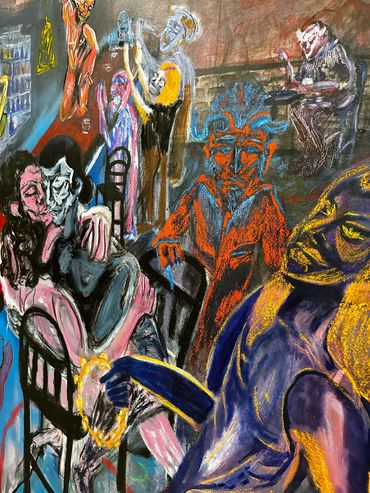MARIA DIAMANTIDOU: NIGHT SHIFT
First solo exhibition of Maria Diamantidou in Athens Greece
Curated by Alia Tsagkari
The exhibition Night Shift by Maria Diamantidou at HGW std. marks the artist's first solo presentation in Athens, following her solo show Psaropoulia in Eressos, Lesvos, a year earlier. Featuring a selection of recent and earlier works from the homonymous series, Night Shift constitutes a profound visual exploration of contemporary late-night culture in Athens, a city undergoing rapid and transformative urban changes. The result of a multifaceted examination of both the visible and invisible aspects of the urban nightscape, Diamantidou’s approach is deeply influenced by oral history, mythology, and psychology.
At the heart of the exhibition is the homonymous, museum-scale work measuring 200 x 400 cm, which recalls the tradition of large-scale paintings typically reserved in academic practice for historical or mythological subjects. Serving as the cornerstone of her new series, Night Shift subverts the established hierarchies of academic painting and redefines what is considered worthy of depiction, bringing to the forefront the ephemerality of an everyday scene from the city's nightlife. Embodying the fervour of expressionism, its scale and plurality of forms create a powerful visual experience that defines the exhibition both thematically and formally. The hybrid, humanoid figures in the composition are voluptuous, rendered in saturated, non-naturalistic colours and accentuated outlines that intensify the sense of dreamlike surreality. Diamantidou’s broad, sweeping brushstrokes impart a sense of movement to the bodies, as if caught in a delirious, metaphysical trance within an interior space, such as that of a bar. However, these protagonists are not merely representations of common people but distorted, almost primitive forms, teetering on the edge of human existence, fusing the imaginary with the mythological. Drawing from the realms of folklore and myth, Diamantidou transforms her subjects into transcendental characters, their bodies and expressions reaching a point of disfigurement, almost demonic—a recurring motif in her work.
Diamantidou's depictions of Athens' nightlife align with a long tradition of artists exploring the after-hours world, as epitomised by Post-Impressionists who were fascinated by bars, cafes, and the bohemian underworld. However, unlike the romanticised portrayals of Athens, Night Shift is stripped of any sense of artificial luxury or nostalgic fantasy. Diamantidou’s Athens is a city in transition; its nightlife is neither purely celebratory nor simply indulgent. Instead, her works reveal a more complex and challenging terrain, where leisure intertwines with existential doubts, and the night becomes a space of revelation for primal desires, fears, and transformations. The central composition of the exhibition is emblematic of this perspective. In it, Diamantidou captures a moment from contemporary Athenian nightlife during a period when the city's urban anthropogeography is undergoing acute changes. The reinvestment in low-income neighborhoods has led to rapid gentrification, transforming not only the physical landscape but also the forms of entertainment. Formerly spontaneous, raw spaces of interaction have been replaced by controlled, sanitized environments designed to cater to the performative aspect of nightlife—where people come and go in a choreographed procession of appearances.
Yet, beneath the banal surface of this modernised, commodified urban landscape, extraordinary realities emerge, which Diamantidou captures in a sensual blend of exoticism and eroticism, deeply connected to the subconscious and the irrational. Her night is not merely a time for social interaction but an initiation into a world where the archaic and mystical reclaim their place, in sharp contrast to the rational, controlled urban environment. Her figures embody this tension between the civilized and the wild, the nocturnal and the primal, suggesting that beneath the polished veneer of modern life lies a deeper, darker, and more primitive human experience. Viewed through this lens, Night Shift exemplifies the artist's ongoing fascination with the intersection of myth, tradition, and contemporary reality in new iconographic and thematic contexts. Through her depictions of the night, she offers a vision of Athens far removed from the sterile, gentrified image of the modern city. Instead, Diamantidou’s Athens is oriental, mystical, and licentious—a place where the boundaries between the real and the imaginary blur, and where the exotic becomes a force of resistance against the creeping homogeneity of contemporary urban life.
By presenting a nocturnal Athens steeped in mystery and excess, Diamantidou challenges viewers to reconsider the spaces they inhabit. Her work reveals how the night can become a site of both personal and collective transformation, a space where the rationality of the day gives way to the chaotic, the fantastical, and the instinctual. In these hidden corners of the urban landscape, we find a reflection of our own deeper, more primitive selves, caught in the eternal dance between order and chaos.




%20.jpg/:/cr=t:0%25,l:0%25,w:100%25,h:100%25/rs=w:370,cg:true)

Copyright © 2025 Alia Tsagkari - All Rights Reserved.
This website uses cookies.
We use cookies to analyze website traffic and optimize your website experience. By accepting our use of cookies, your data will be aggregated with all other user data.